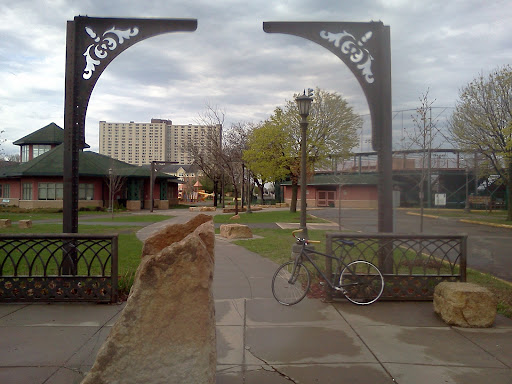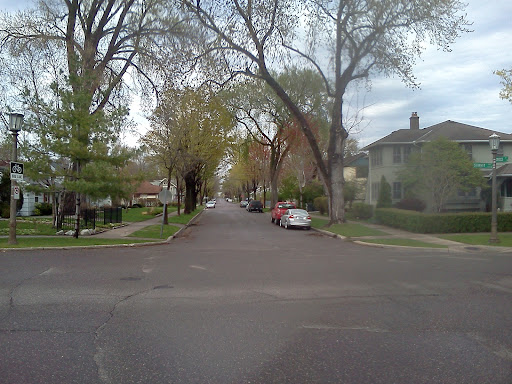The Griggs Street Bikeway is another project funded by the federal Non-Motorized Transportation Program of which “Minneapolis area” is a beneficiary. It will connect to bike routes on Minnehaha Avenue West and Summit Avenue and destinations in between. Approved on January 25, 2012 by the St. Paul City Council, construction is expected to begin some time this year. The bikeway will include pavement markings, traffic circles, audible pedestrian signals, bumpouts, improved lighting, and updates to stoplights.
Full disclosure: I am a member of multiple cycling advocacy groups and a year-round bicycle commuter.The project was presented to the public last October at Dunning Recreation Center, which lies along the center of the future bikeway. I asked Emily Erickson, St. Paul Sustainable Transportation Planner, why the Griggs Bikeway was resolved by the Council in only six months, whereas the Jefferson Avenue Bikeway took four years of public hearings and compromise. She replied that “bike boulevards are a new type of bikeway for Saint Paul, and there’s a learning curve to initiating any new project. Because the process for Jefferson preceded that for Griggs, we were able to employ our lessons learned on the former to help the process for the latter go more smoothly.”
 The learning curve must be steep to reduce a process to one eighth of its former time. Perhaps after such a protracted and emotional conflict over the Jefferson Bikeway, the public sees the process as much ado over such a small something. The learning in the curve involves not just city employees, but also residents. What struck me in researching this article was that so many welcomed the bikeway. In fact, I had to really dig deep to find anything remotely negative.
The learning curve must be steep to reduce a process to one eighth of its former time. Perhaps after such a protracted and emotional conflict over the Jefferson Bikeway, the public sees the process as much ado over such a small something. The learning in the curve involves not just city employees, but also residents. What struck me in researching this article was that so many welcomed the bikeway. In fact, I had to really dig deep to find anything remotely negative.The typical impediments of cycling infrastructure include fiscal minimalism and status quo conservatism. In other words “who’s going to pay for it” and “things are fine the way they are.” Some oppose these projects due to a prima facie disdain for cyclists and support for all things automotive, but they are a minority. Since the money for these projects has already been earmarked, the payment question becomes less prominent.
Also, for many, things are not fine the way they are. As a biker, I have no problem commanding most urban roads, taking the lane, and being traffic, but my perspective is that of a 30-year-old male without children. To make bike and pedestrian infrastructure inclusive, the city needs to consider the needs of different genders, ages, and abilities. Would a mother with her child feel comfortable riding down the bikeway?
One major difference between Jefferson and Griggs is their orientation. Erickson states, “One of the key challenges in biking and walking in Saint Paul is navigating the barriers that transect our north-south corridors. The Griggs Street Bikeway does this by providing a safe connection between our bicycle facilities on Summit and Minnehaha Avenues and across I-94.” Many residents agree. Sonja Mason, who lives on Griggs, welcomes the bikeway and adds, "I'd love to see a bridge over the railroad tracks north of Pierce Butler to get to Como Park." Pierce Butler is designated by signage as a bike route, but traffic is moves faster than 40 mph and the shoulders often strewn with debris.

Looking for input, I posted a thread on the St. Paul Issues Forum on E-Democracy. As with Jefferson, one point of major contention on Griggs is traffic circles. Brian Tourtelotte, who also lives on Griggs, wrote, “I am particularly concerned with compromising pedestrian safety when cars are looking and merging and curving and signaling, and bicycles are looking and merging and curving and signaling.” Traffic circles exist currently in St. Paul and Minneapolis. Seattle has really embraced the idea, installing over a thousand traffic circles. In one study, automobile collisions were reduced by 94 percent.
Locations along Griggs include a Tae Kwon Doe school, Gordon Parks High School, Landfill Books, Common Bond Communities (a large high rise of affordable housing), Holst Hall and Dobberfuhl Hall of Concordia University, Dunning Field, two community gardens, Pizza Lucé, and the Lexington-Hamline Community Council. Griggs is a block from the Midway big box store colony on University, and two blocks from the Lexington Station of the Central Corridor Light Rail. It is six blocks from the Macalester campus and a ends a block north of Grand Avenue. It connects to bike routes on Minnehaha Avenue, Marshall Avenue, and Summit Avenue, and is close to Ayd Mill Road, which has been a proposed bikeway for some time now.
At the end of my short ride down Griggs, I bike to the large median on Summit Avenue and sit down to take it all in. There are joggers and cyclists enjoying the brisk afternoon. I recall that bikeways are not merely a means to get somewhere, they are a somewhere – a place to enjoy in it its own right. I snap my final photo and head south to test out Jefferson Avenue.


No comments:
Post a Comment